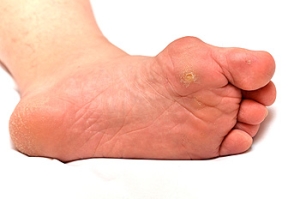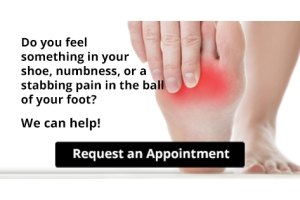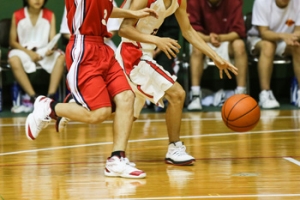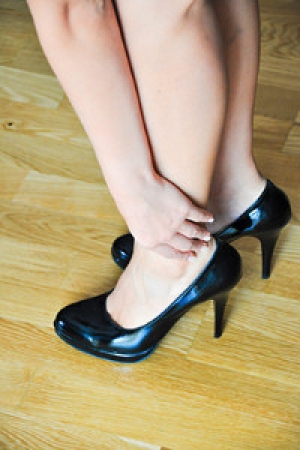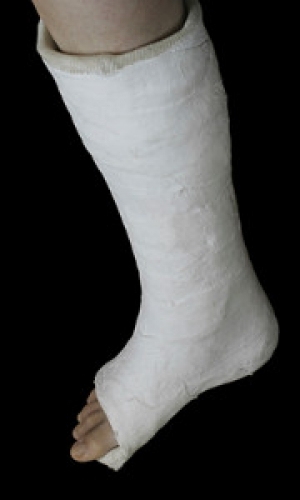Connect With Us
Featured Articles

What is a Soft Corn?
 If the skin becomes reddened and painful, you may be experiencing a corn. Whitened skin and inflammation generally accompany a corn, typically causing severe discomfort. Soft corns develop from shoes that fit poorly, causing friction. Moisture between the toes may grow and accumulate, possibly causing an infection. This can be avoided by incorporating washing and drying between the toes into your daily routine. An effective way to prevent corns is to choose shoes that give the toes ample room to move around, in addition to selecting shoes that have enough cushioning and support. If the pain is affecting your daily routine, a consultation with a podiatrist may be suggested for the best options for relief.
If the skin becomes reddened and painful, you may be experiencing a corn. Whitened skin and inflammation generally accompany a corn, typically causing severe discomfort. Soft corns develop from shoes that fit poorly, causing friction. Moisture between the toes may grow and accumulate, possibly causing an infection. This can be avoided by incorporating washing and drying between the toes into your daily routine. An effective way to prevent corns is to choose shoes that give the toes ample room to move around, in addition to selecting shoes that have enough cushioning and support. If the pain is affecting your daily routine, a consultation with a podiatrist may be suggested for the best options for relief.
If you have any concerns regarding your feet and ankles, contact Dr. Thong V. Truong of California. Our doctor will treat your foot and ankle needs.
Corns: What Are They? and How Do You Get Rid of Them?
Corns can be described as areas of the skin that have thickened to the point of becoming painful or irritating. They are often layers and layers of the skin that have become dry and rough, and are normally smaller than calluses.
Ways to Prevent Corns
There are many ways to get rid of painful corns such as wearing:
- Well-fitting socks
- Comfortable shoes that are not tight around your foot
- Shoes that offer support
Treating Corns
Treatment of corns involves removing the dead skin that has built up in the specific area of the foot. Consult with Our doctor to determine the best treatment option for your case of corns.
If you have any questions please feel free to contact our office located in Chico, CA . We offer the newest diagnostic and treatment technologies for all your foot and ankle needs.
Corns: What Are They, and How Do You Get Rid of Them
Corns are thickened areas on the skin’s surface, to the point of being irritating and sometimes painful. Commonly found on the feet, corns are circular or cone-shaped. They develop where there are areas of pressure or friction, such as on the little toe when it rubs up against shoes, or on the ball of your foot.
Corns are often confused with a callus, but there is a difference between them. Corns can be raised bumps that are painful to the touch. They consist of a rough, thick area of skin that may be dry or waxy. Corns tend to be surrounded by skin that is inflamed, and are usually much smaller than calluses.
Removing the dead skin that has built up is the key in treating corns. Salicylic acid medication is most common in accomplishing this. The acid works by dissolving keratin, which is the protein that makes up the majority of corns. You can purchase salicylic acid over-the-counter in products such as wart removers. It comes in a variety of forms such as medicated pads, drops, or creams. However, people who are diabetic should not use salicylic acid, but should instead consult their doctor immediately.
According to the product directions, applying the medication directly onto the corn will treat it. The top layer of the corn will begin to turn white after use. When that occurs, the layers of skin can then be peeled away, making the corn smaller. Shaving off corns with razors or other pedicure equipment is never a good idea. This can lead to infection. If your corn gets infected, and is not treated immediately, a visit to the doctor will be necessary.
Another way to treat corns and help prevent their return is by using orthotic inserts, fitted by a podiatrist. Inserts fit right into your shoes and adjusts the way your foot fits into your shoes. This fixes the way you walk. This will lower your chances of getting corns, and eliminate current corns by reducing rubbing from friction.
Surgery is rarely used to treat corns, but does occur on occasion. Surgery actually deals with the underlying issue that causes corns. During surgery, the bone is shaved and any abnormalities are corrected, thus reducing the amount of friction that occurs during walking.
To prevent corns, the first step is reducing friction. Always wear shoes that fit well and don’t rub your feet. Pads can be purchased if you notice rubbing developing. These pads can be purchased over-the-counter, and can be simply placed on the irritated area. Wearing cushioned insoles in your shoes can always reduce the friction, and making sure to wear well-fitting shoes. This will ensure that your foot is not being squeezed awkwardly, and prevent corns from forming in the first place.
Why Live with Pain and Numbness in Your Feet?
DeMarcus Cousins Injures Achilles Tendon
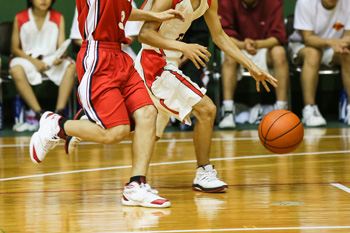 Demarcus Cousins of the New Orleans Pelicans recently ruptured his Achilles Tendon during a Friday night game. With just 15 seconds remaining, Cousins went to rebound on a free throw he missed and landed on his left leg. Now, Cousins must miss the remainder of the season from having to undergo surgery. Cousins will be immobilized for quite some time and have to go through physical therapy to regain strength and range of motion in his ankle and leg. It is said that the rate of recovery from surgery associated with this injury are high. With professional athletes having a different standard of physical health, this injury may hinder their athletic performance in the future. That being said, many people are curious to see how well Cousins will perform when he returns.
Demarcus Cousins of the New Orleans Pelicans recently ruptured his Achilles Tendon during a Friday night game. With just 15 seconds remaining, Cousins went to rebound on a free throw he missed and landed on his left leg. Now, Cousins must miss the remainder of the season from having to undergo surgery. Cousins will be immobilized for quite some time and have to go through physical therapy to regain strength and range of motion in his ankle and leg. It is said that the rate of recovery from surgery associated with this injury are high. With professional athletes having a different standard of physical health, this injury may hinder their athletic performance in the future. That being said, many people are curious to see how well Cousins will perform when he returns.
Achilles tendon injuries need immediate attention to avoid future complications. If you have any concerns, contact Dr. Thong V. Truong of California. Our doctor can provide the care you need to keep you pain-free and on your feet.
What Is the Achilles Tendon?
The Achilles tendon is a tendon that connects the lower leg muscles and calf to the heel of the foot. It is the strongest tendon in the human body and is essential for making movement possible. Because this tendon is such an integral part of the body, any injuries to it can create immense difficulties and should immediately be presented to a doctor.
What Are the Symptoms of an Achilles Tendon Injury?
There are various types of injuries that can affect the Achilles tendon. The two most common injuries are Achilles tendinitis and ruptures of the tendon.
Achilles Tendinitis Symptoms
- Inflammation
- Dull to severe pain
- Increased blood flow to the tendon
- Thickening of the tendon
Rupture Symptoms
- Extreme pain and swelling in the foot
- Total immobility
Treatment and Prevention
Achilles tendon injuries are diagnosed by a thorough physical evaluation, which can include an MRI. Treatment involves rest, physical therapy, and in some cases, surgery. However, various preventative measures can be taken to avoid these injuries, such as:
- Thorough stretching of the tendon before and after exercise
- Strengthening exercises like calf raises, squats, leg curls, leg extensions, leg raises, lunges, and leg presses
If you have any questions please feel free to contact our office located in Chico, CA . We offer the newest diagnostic tools and technology to treat your foot and ankle needs.
What are Achilles Tendon Injuries
The Achilles tendon is the strongest tendon in the human body. Its purpose is to connect the lower leg muscles and calf to the heel of the foot. This tendon is responsible for facilitating all types of movement, like walking and running. This tendon provides an enormous amount of mobility for the body. Any injuries inflicted to this tissue should be immediately brought up with a physician to prevent further damage.
The most common injuries that can trouble the Achilles tendon are tendon ruptures and Achilles tendinitis. Achilles tendinitis is the milder of the two injuries. It can be recognized by the following symptoms: inflammation, dull-to-severe pain, increased blood flow to the tendon, thickening of the tendon, and slower movement time. Tendinitis can be treated via several methods and is often diagnosed by an MRI.
An Achilles tendon rupture is trickier to heal, and is by far the most painful injury. It is caused by the tendon ripping or completely snapping. The results are immediate and absolutely devastating, and will render the patient immobile. If a rupture or tear occurs, operative and non-operative methods are available. Once the treatment begins, depending on the severity of the injury, recovery time for these types of issues can take up to a year.
Simple preventative measures can be taken as a means to avoid both injuries. Prior to any movement, taking a few minutes to stretch out the tendon is a great way to stimulate the tissue. Calf raises, squats, leg curls, leg extensions, leg raises, lunges, and leg presses are all suggested ways to help strengthen the lower legs and promote Achilles tendon health.
Many problems arise among athletes and people who overexert themselves while exercising. Problems can also happen among those who do not warm up properly before beginning an activity. Proper, comfortable shoes that fit correctly can also decrease tendon injuries. Some professionals also suggest that when exercising, you should make sure that the floor you are on is cushioned or has a mat. This will relieve pressure on the heels. A healthy diet will also increase tendon health.
It is very important to seek out a podiatrist if you believe you have an injury in the Achilles region. Further damage could result in severe complications that would make being mobile difficult, if not impossible.
How Can Wearing High Heels Affect My Feet?
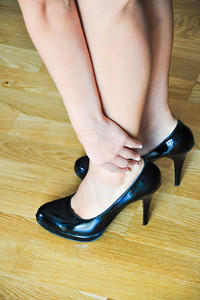 The choice to wear high heels can not only be damaging to the heel, but generally puts pressure on the front of the foot as well. Another part of the foot typically affected may be the Achilles tendon. When high heels are worn frequently, the tendon becomes shortened, and the back of the ankle may feel tight as it strains to be flexible. Arthritis may be a result of damage incurred to the joints of the feet from wearing high heels. Additionally, disorders such as bunions, corns, and a thickening of the nerves between the toes, referred to as Morton’s neuroma, may also be the result of choosing this type of shoe to wear. If you do decide to wear high heels, you can reduce the impact that’s endured by placing protective pads in the shoes. When proper stretches are performed, the foot and ankle will not only feel better, but become stronger.
The choice to wear high heels can not only be damaging to the heel, but generally puts pressure on the front of the foot as well. Another part of the foot typically affected may be the Achilles tendon. When high heels are worn frequently, the tendon becomes shortened, and the back of the ankle may feel tight as it strains to be flexible. Arthritis may be a result of damage incurred to the joints of the feet from wearing high heels. Additionally, disorders such as bunions, corns, and a thickening of the nerves between the toes, referred to as Morton’s neuroma, may also be the result of choosing this type of shoe to wear. If you do decide to wear high heels, you can reduce the impact that’s endured by placing protective pads in the shoes. When proper stretches are performed, the foot and ankle will not only feel better, but become stronger.
High heels have a history of causing foot and ankle problems. If you have any concerns about your feet or ankles, contact Dr. Thong V. Truong from California. Our doctor can provide the care you need to keep you pain-free and on your feet.
Effects of High Heels on the Feet
High heels are popular shoes among women because of their many styles and societal appeal. Despite this, high heels can still cause many health problems if worn too frequently.
Which Parts of My Body Will Be Affected by High Heels?
- Ankle Joints
- Achilles Tendon – May shorten and stiffen with prolonged wear
- Balls of the Feet
- Knees – Heels cause the knees to bend constantly, creating stress on them
- Back – They decrease the spine’s ability to absorb shock, which may lead to back pain. The vertebrae of the lower back may compress.
What Kinds of Foot Problems Can Develop from Wearing High Heels?
- Corns
- Calluses
- Hammertoe
- Bunions
- Morton’s Neuroma
- Plantar Fasciitis
How Can I Still Wear High Heels and Maintain Foot Health?
If you want to wear high heeled shoes, make sure that you are not wearing them every day, as this will help prevent long term physical problems. Try wearing thicker heels as opposed to stilettos to distribute weight more evenly across the feet. Always make sure you are wearing the proper shoes for the right occasion, such as sneakers for exercising. If you walk to work, try carrying your heels with you and changing into them once you arrive at work. Adding inserts to your heels can help cushion your feet and absorb shock. Full foot inserts or metatarsal pads are available.
If you have any questions please feel free to contact our office located in Chico, CA . We offer the newest diagnostic and treatment technologies for all your foot and ankle needs.
Effect of High Heels on the Feet
For hundreds of years, women have been wearing various kinds of high heels for aesthetic reasons. Women who wear high heels appear to be taller and have longer and thinner legs, and the wearer’s gait and posture changes. Though high heels have had an association with femininity and have kept them popular over the years, there are definite health problems caused by wearing them too frequently.
The motion of the ankle joints is limited when heels are worn. The ankle joint is very important to the body when it comes to walking. Because of their location, these joints have a great deal of weight put on them. Thus, it is very important to keep them as healthy as possible. The Achilles tendon is the main tendon in the ankle. Wearing high heels too often, studies have shown, can cause the calf muscle and Achilles tendon to shorten and stiffen. This can cause problems when shoes without heels are worn.
By putting a great deal of pressure on the ball of the foot and by forcing the toes into a small toe box, high heels can cause or may worsen many foot problems. These include corns, hammertoe, bunions, Morton’s neuroma and plantar fasciitis.
Not only does wearing high heels regularly have negative effects on the feet, the rest of the body can suffer as well. The knees, one of the most important joints in the entire body, can be affected by wearing high heels. High heels can cause the knees to stay bent all the time. Also, it can cause them to bend slightly inward as well. Doctors believe that women can suffer from osteoarthritis later in life because of constantly walking like in high heels. By limiting the natural motion of the foot during walking, high heels also cause an increased in stress on the knees.
Similarly, high heels can cause the back to go out of alignment. If high heels are worn constantly, the spine’s ability to absorb shock can cause continued back pain. They can compress the vertebrae of the lower back, and can overuse the back muscles.
However, this is not to say that high heels can never be worn. If worn occasionally and not often, they will not cause serious problems. They should not be worn every day. It’s important to wear them modestly to avoid the long-term physical health problems of the feet, knees, ankles, and back mentioned above.
How A Broken Ankle is Treated
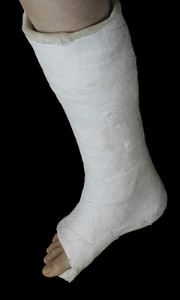 If you have fallen and are experiencing severe pain, swelling, or difficulty in moving your foot, you may have a broken ankle. It may be challenging to differentiate between a break and a sprain; therefore, an X-ray is often taken for a proper diagnosis. Keeping the leg elevated will help with the swelling that occurs, and limiting weight on the affected ankle will aid in alleviating the discomfort associated with this painful injury. If a minor fracture is incurred, wearing a supportive boot or splint may be recommended, as well as using crutches to keep the weight off the ankle. For a more serious fracture, surgery may be suggested to realign the bones, and a cast will be fitted to promote proper healing. It generally takes 6-12 weeks for improvement to occur, but this time frame will vary from patient to patient. If you suspect that your ankle may be broken or sprained, see a podiatrist immediately.
If you have fallen and are experiencing severe pain, swelling, or difficulty in moving your foot, you may have a broken ankle. It may be challenging to differentiate between a break and a sprain; therefore, an X-ray is often taken for a proper diagnosis. Keeping the leg elevated will help with the swelling that occurs, and limiting weight on the affected ankle will aid in alleviating the discomfort associated with this painful injury. If a minor fracture is incurred, wearing a supportive boot or splint may be recommended, as well as using crutches to keep the weight off the ankle. For a more serious fracture, surgery may be suggested to realign the bones, and a cast will be fitted to promote proper healing. It generally takes 6-12 weeks for improvement to occur, but this time frame will vary from patient to patient. If you suspect that your ankle may be broken or sprained, see a podiatrist immediately.
Broken ankles need immediate treatment. If you are seeking treatment, contact Dr. Thong V. Truong from California. Our doctor can provide the care you need to keep you pain-free and on your feet.
Broken Ankles
A broken ankle is experienced when a person fractures their tibia or fibula in the lower leg and ankle area. Both of these bones are attached at the bottom of the leg and combine to form what we know to be our ankle.
When a physician is referring to a break of the ankle, he or she is usually referring to a break in the area where the tibia and fibula are joined to create our ankle joint. Ankles are more prone to fractures because the ankle is an area that suffers a lot of pressure and stress. There are some obvious signs when a person experiences a fractured ankle, and the following symptoms may be present.
Symptoms of a Fractured Ankle
- Excessive pain when the area is touched or when any pressure is placed on the ankle
- Swelling around the area
- Bruising of the area
- Area appears to be deformed
If you suspect an ankle fracture, it is recommended to seek treatment as soon as possible. The sooner you have your podiatrist diagnose the fracture, the quicker you’ll be on the way towards recovery.
If you have any questions, please feel free to contact our office located in Chico, CA . We offer the newest diagnostic and treatment technologies for all your foot care needs.
